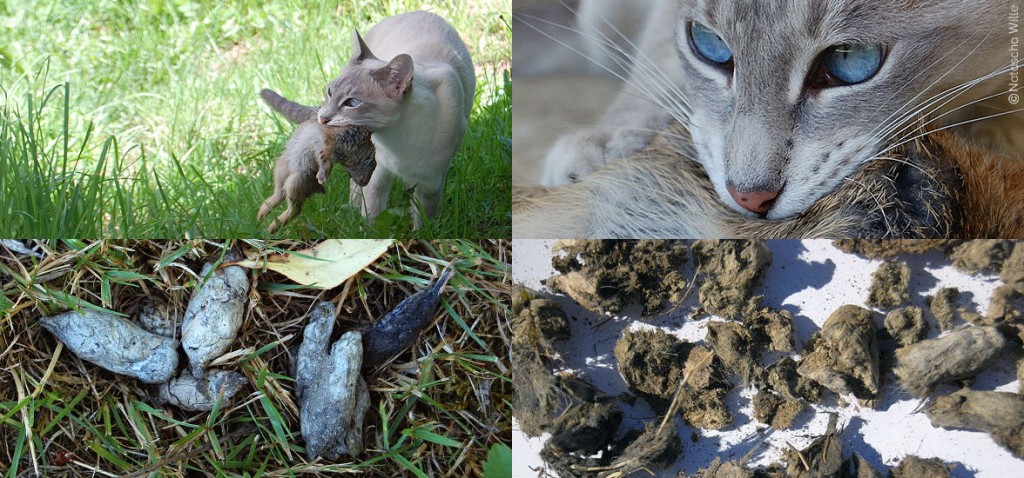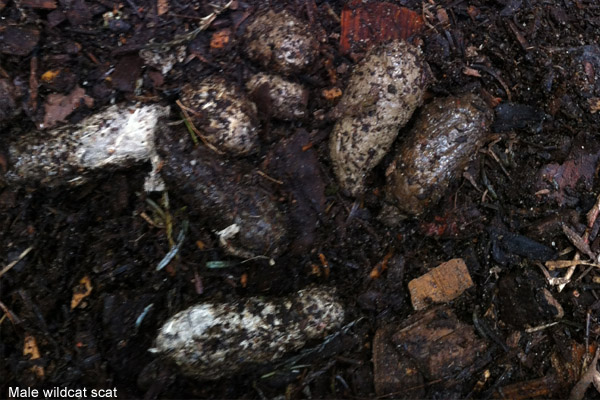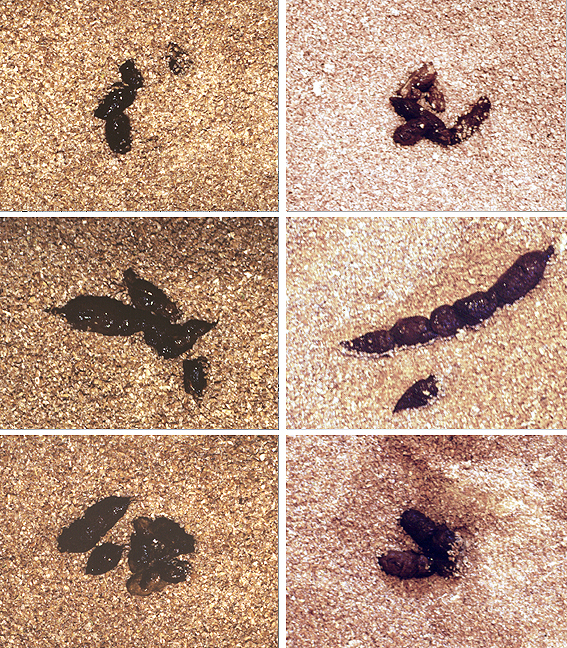One of the immediate results when feeding my raw cat food is less cat poop, and cat poop that smells less. While some cat owners welcome this change, some are concerned that their cats might be constipated.
Feeding raw can closely resemble nutritionally what cats would eat naturally if living wild in their native habitat. It is, however, not a truly natural diet. The natural diet can only be replicated by feeding small whole prey. One of the biggest differences between feeding raw and the natural prey diet is fur. Fur, ingested with prey, has no nutritional function, but serve two key mechanical functions which we lack when feeding a home-made raw diet: A.) by action of cats biting down on small prey, the fur of the prey is brushing up against the teeth of cats, helping to wipe away plaque and preventing accumulation of tartar. B.) it has an important role as a stool bulker. Unfortunately, fur is next to impossible to substitute in the raw meat diet, because we can not add hair or fur to a recipe.
Above: my cat Charlie hunts and eats wild Eastern Cottontail rabbits. The juvenile rabbits he is mostly catching weigh up to 500 gram (~ 1 pound) and he will consume most of it. Stomach, intestines, and cecum are always left behind, and so are the feet. The head is often eaten. Otherwise, Charlie eats the whole rabbit – skin, fur and bone. Note how his teeth sink into the fur – wiping away plaque on the teeth. The resulting scat from Charlie is deposited as little dry pellets which are very light. They are almost like dense felt. Their content is crumbly digested bone, lots of hair, some grass and even teeth from the rabbit. (Click to enlarge image)
Having evolved in the dry climate of Africa and the Near East, cats are superbly equipped to conserve water. They do not sweat and rarely pant; they concentrate their urine to a high degree and extract all possible fluids from feces before they leave their body. They are so efficient in conserving water that they can exist on the fluids provided by eating prey alone. Their feces will naturally be very firm, pellet-like, dry, and off-white or with a yellow tint. Their content will be crumbly, held together largely by hair – cat hair and that of prey. Below is an image of scat from a wild African Wildcat (Felis lybica), courtesy of the Hoedspruit Endangered Species Centre in Africa.
The following image is scat from a wild Scottish Wildcat (Felis silvestris grampia) courtesy of Highland Tiger (Royal Zoological Society of Scotland).
If your cats’ feces look similar to the above images, it is probably perfectly normal and your cat is not constipated.
Above: scat study from 1998 with my own cats. Left column of images is scat from cats eating frozen mice. Right column is scat from the same cats eating my raw food which also contained Psyllium husk. No difference.
Some cats have genuine problems with constipation. Restlessness, lack of appetite, vomiting, and frequent trips to the litterbox to defecate unsuccessfully requires Veterinary attention. A Veterinarian will help to diagnose its cause and find an appropriate solution, because constipation is not always diet related. To relieve the acute condition, A Veterinarian will administer an enema and prescribe medication and laxatives. For cats with recurring problems with constipation, daily inclusion of laxatives like Polyethylene Glycol 3350 (sold over the counter as RestoraLAX in Canada) is probably the best choice.
WATER. Adding more water to the diet to help make feces softer does not work. Cats physiology is such that they naturally extract as much moisture from feces as possible before voiding them. Adding water to food will increase urine output, but at the same time reduce food intake, because the same volume of food now contains more moisture. Reduced food intake will result in fewer feces and makes constipation worse.
INCREASED FOOD INTAKE. I have observed that kittens are rarely constipated. Every day they void nice feces on the raw food. Compared to adult cats, kittens consume proportionally much more food to support their daily energy requirements and growth. Active cats that eat more food to support the energy requirement of their lifestyle also have larger and more frequent bowel movements. Simply put, food volume translates into fecal volume. Increased food intake signals more frequent emptying of the bowel. If inactive cats require a calorie restricted diet to stay trim and healthy, we can expect that few feces are voided. Often, if fecal volume is small, cats will not void feces on a daily basis, but every second or third day. As long as they are voided, this is normal. It is also normal for infrequently voided feces to be much drier, because the colon will have more time to absorb more moisture from them.
CAT HAIR. If the fur of prey is an ideal stool bulker, then cat hair is a second best. Cats will naturally ingest a lot of their own hair during grooming, and this should not be discouraged. Excessive brushing and bathing may leave your cat short on laxatives. Cat hair should pass through the entire alimentary tract without causing any concern. Healthy cats eating my raw food regurgitate almost no hair balls. If cats regurgitate hairballs, crave eating grass, and bring food back up then something is not right and they should be seen by a Veterinarian if these behaviors occur often. It may indicate that there is an underlying illness that is causing nausea.
BONE. The feeding of raw bones or bone meal has been linked to constipation. There are two sides to feeding bones, however. Meat with bone recipes deliver an excess of dietary Calcium, because bones also delivers large quantities of Phosphorus, which must be balanced by more Calcium or more bones. An excess of Calcium in the diet can contribute to constipation. But bones are not entirely made of Calcium Phosphate or minerals. Bones are mostly a dense protein matrix in which the mineral are laid down. This protein matrix is largely indigestible and, as a result, bulks stool.
MAGNESIUM. Calcium can contribute to constipation, while Magnesium may be used to relieve it. Magnesium has many functions in the body, including buffering stomach acid and moving stool through the intestines. As an essential mineral it must be present in the diet in sufficient amounts, but due to its connection to urinary struvite crystals, many diets for cats are low in Magnesium. Some cases of constipation could, therefore, be a Magnesium deficiency. A dose of Magnesium can be used therapeutically as a laxative. The laxative property of Magnesium has two mechanisms. Magnesium is essential for proper muscle function and responsible for a smooth rhythm of the intestines. Magnesium also attracts water, increasing the amount of water in the colon to help soften the stool.
DRY CAT FOOD. Often, for those not opposed to feeding a combination diet of raw foods and commercial foods, feeding some dry foods adds all the bulk needed to the diet. As long as the diet is mostly comprised of raw or wet foods, feeding some dry food to keep cats regular should not expose them to the same risks as feeding exclusively dry food (cats exclusively fed dry food often have a inadequate intake of water which predisposes them to bladder and kidney disorders). Feeding a diet entirely made up of dry food can, however, be a cause of constipation. Dry cat food as the sole diet leaves many cats in a chronic state of mild dehydration. Dry cat food is also very stool bulking, and the feces are often too large to pass easily. This cause some cats to avoid voiding them, which creates a very real risk of a condition called Mega Colon.
RAW LIVER AND FAT. Raw liver can act like a mild laxative. Increasing the fat content of the meat used to make the diet can encourages a faster transit time of matter through the digestive tract and can encourage more frequent emptying of the bowel. Mild flavored vegetable oil like canola or sunflower oil can be added to the food as well or instead of using fattier meats. Some cats really enjoy olive oil and will lap it up pure. Vegetable oils are not as easily digested by the cat and may help hasten things along in a similar manner as oral petroleum jelly remedies would.
PUMPKIN. By far one of the most popular home-remedies for constipation chosen by Veterinarians and owners alike is inclusion of pure canned pumpkin to the diet. Results are mixed. According to data by the USDA, canned pumpkin is 90% moisture and 2.8% fibre. That means that mostly water is added to the cat food with each tablespoon of canned pumpkin, and hardly enough fiber to make any difference. This means that canned pumpkin is not a stool bulker, but must have other laxative effects. I have heard that canned pumpkin has short-lived effects, however. Cats appear to get accustomed to it, and feces return to being small, dry, and infrequent. Although canned pumpkin is accepted by many cats, some cats will not eat food in which it was included.
GROUND SUNFLOWER SEEDS. Sunflower seeds represent an interesting solution to help bulk stool. They are very mild in flavor and practically indigestible for cats, which means that they pass through the alimentary tract of cats fairly unchanged. They can be ground into a powder with the help of an electric coffee bean grinder.
GROUND FLAX SEEDS. Flax seeds must be used with great caution, if they are used at all. They are a popular fibre supplement for people, which doesn’t mean they are completely safe for cats. Flax seeds must be added to the food just before cats eat it, or they must be boiled first. All flax seeds contain cyanocenic glycosides which release toxic hydrogen cyanide in the presence of water. The longer raw flax seeds sit in water (or in raw food!), the greater the concentration of toxins. Boiling the flax seeds neutralizes the toxin. Flax seeds are best used finely ground, or use a defatted flax fiber supplement. Remember to boil all flax products before including them in cat food. Flax, boiled in water, creates a gelatinous texture that creates an overall pleasing food texture and may aid in increasing moisture of feces.
PSYLLIUM HUSK. Psyllium husk, also sold as the popular brand “Metamucil”, is a well known remedy for preventing constipation in humans. It is also used by some Veterinarians and cat owners for cats with constipation. Its effectiveness may be short lived, however. It appears that with long term inclusion the remedy loses its effectiveness. It is, therefore, best used as a short term therapeutic remedy. CELLULOSE GUMS have a similar function and in a similar way as Psyllium husks lose their effectiveness if used long term.
BRAN. Bran is a well known source of fibre from wheat, oats, or rice. Wheat and rice bran is not very palatable. Oat bran is high in starch. Personally, I would not subject cats to any form of bran for fear of causing undue discomfort like regurgitation, vomiting, gas, or diarrhea.
Do cats need a source of fibre in their diet? Fibre is not considered essential for simple stomach carnivorous mammals like cats. As part of their natural prey diet, cats do not ingest dietary plant fibre and their digestion requires no substrate or medium for food fermenting bacteria to live on. Fibre plays an important role in the diet of omnivores, and is essential in the diet of herbivores which exist largely on byproducts created by bacterial fermentation of cellulose (fibre), but cats as strict carnivores have no natural need for fibre.
Introducing plant fibre or starches into the digestive tract of cats means creating a habitat for bacteria which might otherwise not multiply there or be part of the natural gut flora of cats. When these bacteria proliferate and begin to ferment the fibre and starches they create gases which can not only be very uncomfortable to cats, but they can also be toxic and cause inflammation. Inflammation of the intestines will then result in loose stool or diarrhea. Inclusion of plant based fibres and starches in the diets of cats needs to be approached with caution and cats need to be observed for regurgitation, excessive gas, or irritation of the lower digestive tract resulting in loose stool or diarrhea. High levels of fibre in the diet of cats from excessive inclusion of foods or supplements from plant source can depress digestibility of nutrients and outright displace nutrients. Sometimes the cause of constipation is not related to the diet or lack of bulk in the diet, in which case adding fibre will not promote stool bulking and more frequent bowel movements.
Cats with a tendency to regurgitate their food should not be given fibre, because fibre supplements or addition of vegetables may increase the frequency of regurgitation. Cats that regurgitate food should be fed several small meals of highly digestible food throughout the day. They should not have essential nutrients and calories replaced by bulk in their diet. Constipation in these cats may simply be the result of a lack of food volume passing through the digestive tract. Consistent, small meals throughout the day of highly digestible food should soon remedy this while, with the help of a Veterinarian, the underlying cause of the repeated regurgitation of food is being investigated.





